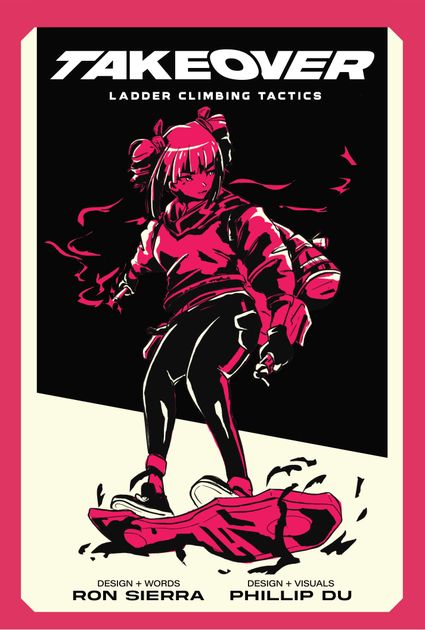SMOOSH JUICE
Designer Diary: Takeover, or How I Stopped Hating Ladder Climbers | BoardGameGeek News

by Ron Sierra
I used to hate ladder climbers, that is, card games that have players essentially outbidding each other with increasingly stronger sets of cards. It’s a genre that never worked for me and one that I was (and still am) frankly bad at: the lockouts, a merciless must follow structure, the forced passes, unwinnable opening hands — it all felt frustrating.
And that’s why on March 23, 2025, we’re releasing Takeover: Ladder Climbing Tactics, a card game for 2-4 players, at Game Market West. Why the change of heart? Well, it all started with an embarrassing attempt to dethrone a classic.
Taking on Big 2
My non-gamer friends love Pusoy Dos, a.k.a. Big 2, a Filipino variant of climbing games with Cantonese origin. Pusoy — the San Francisco Bay Area name — is a ladder-climbing game that utilizes poker hands and a standard 52-card deck. It’s fast, simple, and deceptively deep, but for reasons listed in the intro, I’d rather play another card game. The fact that Big 2 is a staple with my non-gamer friends did, however, make me think that my design partner and artist, Phillip Du, and I could make a middle ground.
We conducted market research (e.g., looked at the BGG hotness), studied the best ladder climbers (535, anyone?), tapped into our impeccable taste in games, and used that knowledge to create a “better” version of a beloved classic that millions of people have played for decades. Easy, right?
A few months later, we delivered printed copies of “Pusoy Bois” — “bois” is gender neutral in our friend group — exclusively to our friends. The game was designed to make ladder climbing more flexible in two ways:
1. Replace passing with two action cards to let you play cards from a market, swap those cards with cards from hand, or draw four cards, then discard four cards.
2. Break the rigid “must follow with the same type of meld structure”, making it so that runs could beat sets and vice versa.
All in all, it’s a gambley, swingy, and open-ended take on Pusoy Dos. Reviews among the “bois” were split. One friend said, “You did it. This is a good alternative for players who have played a lot of Pusoy.” Nice.
Another said, “You shouldn’t have called it Pusoy.” Oof.
A year later, what game do you think they’re still playing?
While we had achieved some of the flexibility we were aiming for, we’d also created a more convoluted and luck dependent game than Big 2. “Pusoy Bois” also lacked the deduction element, intuitive poker hands, and table reads of the base inspiration. The additional options that replaced pass were welcome, but overly complicated in procedure. Ultimately, “Pusoy Bois” failed to understand the game it was responding to and came short of its impossible ambition to dethrone a classic.
Every one of these lessons eventually made it into Takeover.
The Road to Game Market West 2025
In 2024, board game designer and event organizer Johnny Chin announced submissions for Game Market West. This event was admirably created to replicate the magic of the legendary Tokyo Game Market here in California, offering indie game designers a place to showcase and sell their games.
With “Pusoy Bois” fresh on our minds, we figured creating a spiritual successor would be the best path forward. The goal to create a ladder climber with “outs” remained, along with the flexible follow structure, but we added a new theme, usability improvements, and meld-based powers that let you do things like steal the initiative.
Fast forwarding to testing, “Pusoy Bois 1.5” was underwhelming at best and forgettable at worst. Even with new well-received additions like powers, players didn’t seem invested in the action. I decided to write a mock review to figure out why the design wasn’t working. Here’s an excerpt from, uh, myself:
Ironically, the game’s flexibility resulted in a lack of control. Pair this open-endedness with RNG-heavy actions based on you hoping for a hit, and players ended up feeling like their decisions didn’t matter — win or lose.
To boost the control and predictability, we reworked the special card actions that replaced pass to make them more reliable. We added an almost trick-taking game-like structure to make rounds more strategic. Four melds total would be played in a round versus continuing until someone couldn’t beat the meld. That just left the meld powers, which were being used almost randomly.
As part of our ongoing research, we played Thomas Lehmann‘s Chu Han, a sharp and tense two-player ladder climber set in dynastic China. I noticed something here that I saw in Taylor Reiner‘s ingenious almost-shredder Seers Catalog and Lee Gianou‘s Bridge City Poker: powers were dedicated to a single card versus a whole meld. Why had all these designers chosen the same solution? Must be something about their games, I told myself so that I wouldn’t have to give up our “original” take on powers. That stubbornness held for only about a week.
Throughout our tests, one power that forced only singles out surfaced as a regular player favorite. It added a control and predictability that was inherent to traditional ladder climbers. You could deduce which cards might get played and plan accordingly. Testers wanted more of that.
So what if we tried something wild? What if we went back to forcing players to play the same type of melds against each other? You know, a traditional ladder-climbing structure integrated into the new round and action system. In short, it was time to make a new game.
This pivot brought deduction and predictability back in and as was foreshadowed we moved to a single-card power system, increasing their reliability and impact. All these changes took us from “Pusoy Bois 1.5” to what would become Takeover.
Playing Beyond the Hand You’re Dealt
Across all versions of our ladder-climbing designs there had been one constant: a shared market that could be used to better your hand or play melds from. These community cards gave us the flexibility we were looking for, a way for players to play beyond the hand they were dealt.
In Takeover, instead of passing your turn as in traditional ladder climbers, you have two alternative actions: deploy and plan. Deploy lets you discard a specific power card for its effect. Plan lets you draw 1-3 cards from the deck and place those cards into a shared market called The Undercity, after which you make one of two choices:
• Plan A: Use cards in hand with cards in The Undercity to play a viable meld.
• Plan B: Swap or take cards from The Undercity.
These options don’t come without risk. The Plan action takes up your whole turn, and when drawing you might hit one of three defect cards that force you to swap out the strongest card in your hand with a potentially weaker one from the market.
These market-related actions are what you could call Takeover‘s hook, our twist on the genre. These flex actions get around the lockouts, let players improve their hands, and add some depth in the form of baiting plays and opening up long-term hand building. This doesn’t give players complete control, though, as the plan and deploy actions give away information, opportunities, and tempo to opponents. All together, players get a decision space rich with pushes for tempo, risky gambits, tense turns, and late game pivots. Wait, is that what ladder climbers were about this whole time?
I Had Ladder Climbers All Wrong
As design wrapped on Takeover, I finally understood that my dislike for ladder climbers and shedders was due in part to a huge misconception. The must-follow-melds “lockout” and the bad hands I saw as flaws in the genre are the critical constraints that make ladder climbing compelling. It’s the puzzle of those restrictions in tandem with the bidding battles that generate a story and the sport of the card play.
This all comes down to a cliché you hear in creative writing classes. To break a rule, you must understand the rule — so what did I come to understand? Being forced to follow meld limitations created the need to sequence out your hand, not unlike trick taking, while also providing opportunities for gambits, minor bluffs, clever table reads, and strategic blunders. The rule that seemed to get in the way of the fun was actually making the fun.
The solution for Takeover was never to mess with what works, but to alleviate the more controversial elements of ladder climbers. In doing so, I think we’ve ended up with a fresh take on the genre and at the very least a newfound appreciation for everything that frustrated me about ladder climbers.
To try or buy Takeover, come out to Game Market West on March 23, 2025 at the Guildhouse in San Jose, CA. It’s free and will showcase indie tabletop games from all over. Alternatively, you can get the game directly from the FinalFinal Games website.

/pic8749071.jpg)
/pic8760936.jpg)
/pic8762845.jpg)
/pic8762900.jpg)
/pic8760933.jpg)
/pic8001986.jpg)
/pic8074402.jpg)
/pic6327308.jpg)
/pic8760938.png)
/pic8760942.jpg)
/pic8748992.png)